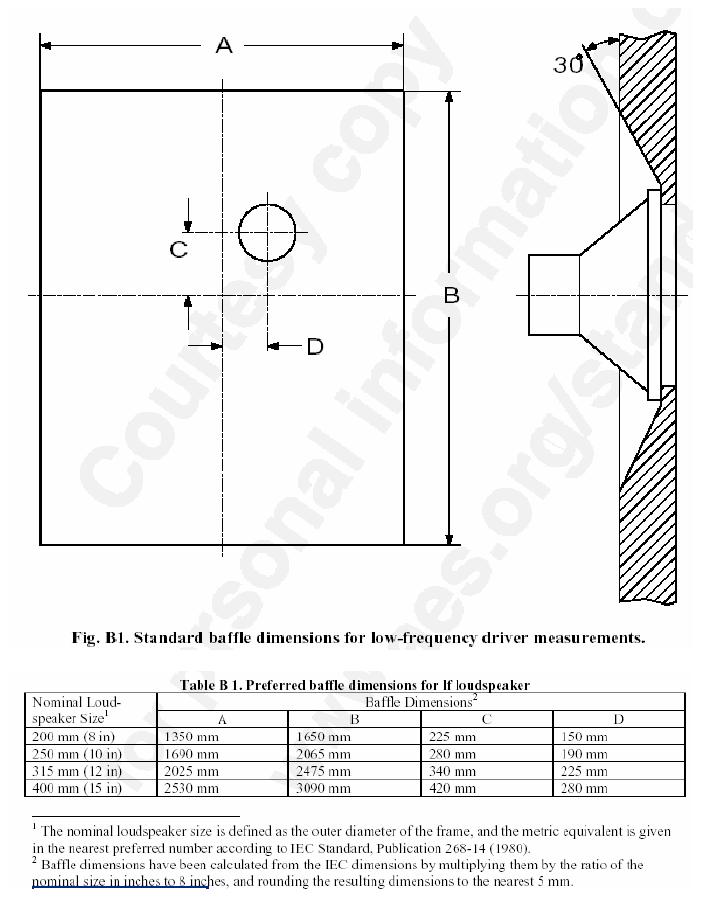Do they take frequency response measurements using infinite baffle, a standard baffle, a standard box, or something else? PE and MCM appear to have data from CLIO--does it require a particular setup?
There are "guidelines" moreso than standards when it comes to speaker measurement. Most of the measurements are made on a baffle, open on both sides. There are official IEC sizes for measurement baffles, but unless the datasheet specifically calls out what baffle was used, do not assume that it was a particular standard baffle.
IEC Baffle Sizes from Roman Bednarek's pages:

There are some standard distances from which speakers are measured, the most common being 1m. Moving the microphone can result in different response curves, and I would suspect it is not uncommon for manufacturers to use the measurement distance which is most flattering to their product. Again, if the distance is not called out on the datasheet or given on the companies webpage, take it with some salt.
Manufacturers measurements, and third-party measurements for that matter, are only one minor tool in the speaker selection process. Even if the measurements are accurate for the test baffle conditions, the response will change greatly when placed into a speaker enclosure.
CLIO is a measurement package (software and hardware). There are many other measurement suites out there, ranging from free (speaker workshop) to very expensive.
-David
IEC Baffle Sizes from Roman Bednarek's pages:

There are some standard distances from which speakers are measured, the most common being 1m. Moving the microphone can result in different response curves, and I would suspect it is not uncommon for manufacturers to use the measurement distance which is most flattering to their product. Again, if the distance is not called out on the datasheet or given on the companies webpage, take it with some salt.
Manufacturers measurements, and third-party measurements for that matter, are only one minor tool in the speaker selection process. Even if the measurements are accurate for the test baffle conditions, the response will change greatly when placed into a speaker enclosure.
CLIO is a measurement package (software and hardware). There are many other measurement suites out there, ranging from free (speaker workshop) to very expensive.
-David
David, thanks for the test baffle design diagram--that'll help me lay out the baffle simulation.
I may not have included enough context in my question:
I'm launching into my first crossover design using the Frequency Response Consortium's set of FRD tools. I think I have a handle on it and am at the point of separating out measurement conditions from the manufacturer's response curves.
Candidate drivers include (this is a low-budget project):
Vifa BC25SC55-04 textile tweeter
Vifa DQ25S16-04 Ti tweeter
Dayton DA135-8 Al woofer
MCM 55-3870 Al woofer
Test conditions are not noted on the spec sheets, so I was wondering whether anyone knows how those manufacturers set up their tests.
Thanks!
I may not have included enough context in my question:
I'm launching into my first crossover design using the Frequency Response Consortium's set of FRD tools. I think I have a handle on it and am at the point of separating out measurement conditions from the manufacturer's response curves.
Candidate drivers include (this is a low-budget project):
Vifa BC25SC55-04 textile tweeter
Vifa DQ25S16-04 Ti tweeter
Dayton DA135-8 Al woofer
MCM 55-3870 Al woofer
Test conditions are not noted on the spec sheets, so I was wondering whether anyone knows how those manufacturers set up their tests.
Thanks!
- Status
- Not open for further replies.